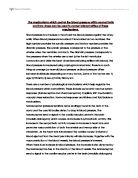Tunica Media-This is the milled layer of walls in veins and arteries. This consists of smooth muscle and elastic fibre. This is thicker in the walls of arteries because it has to withstand higher blood pressure.
Tunica Intima-This is the inner layer of arteries and veins. This layer contains elastic membrane lining (arteries only, veins do not contain this) and smooth endothelium that is covered by elastic tissues.
This diagram shows the interior of arteries and veins
Amanda Alderson
Access to Healthcare (day)
8th November 2003
ARTERIES
Arteries carry oxygenated blood away from the heart with the exception being the pulmony artery. The pulmony artery carries de-oxygenated blood from the right ventricle of the heart. It branches out into two in order to take blood to both lungs. The heart contracts and pushes blood in the arteries under high pressure. As blood is forced through an artery it is pressed against the artery wall, stretching the elastic tissue. The tissue then springs back and the blood is squeezed along the artery. The largest artery in the body is called the Aorta and this vessel comes from the left ventricle of the heart to form an arch, this is known as the aortic arch. It then extends down to the abdomen and branches off into smaller arteries. When we measure blood pressure the blood flowing through our arteries are used as they are a higher pressure than veins. You can feel arteries expand and contract, we know this as a pulse. The artery is then divided into smaller vessels called arterioles. The muscles in the walls of arterioles help regulate the flow of blood to the tissues of the body. Arterioles dived even further into even smaller vessels called capillaries.
CAPILLARIES
Capillaries form a network of vessels called a capillary bed in the organs of the body. The capillary bed enables each living cell to be near a flow of blood. The walls of capillaries are made up of very thin flat cells, these are called endothelial cells. Capillaries are so small that blood cells can only go through one by one.
Oxygen, carbon dioxide, nutrients and waste products are exchanged here. The flow of blood is controlled by valves called precapillary sphincters which are located between the arterioles and capillaries and contain muscle fibre to allow them to contract. When they are open blood flows to the capillary bed of body tissue, when closed then blood flow is stopped. Capillaries are also involved with body release of excess heat.
VENULES
The capillary network connects to venules which are thicker than capillaries. They are approximately 20-30um in diameter. Venules unite to form small veins. These vessels provide a low pressure reservoir to enable the blood to start their journey back towards the heart.
Amanda Alderson
Access to Healthcare (day)
8th November 2003
VEINS
Veins carry de-oxygenated blood to the heart (with the exception of the pulmonary vein). The largest vein in the body is called the vena cava (of which there are two of these). The superior Vena Cava carries blood from the head and upper limbs into the
right pump in the heart. The other vein called the inferior Vena Cave carries blood from the other regions of the body also to the right pump in the heart. There are two types of veins, the first one being a superficial vein. This type passes just under the skin and can be seen as bluish in colour. This is because it has less oxygen in than an artery would have. When you cut yourself the blood is seen as a rich red colour because the oxygen from outside the body reacts with the haemoglobin in your blood. The other type of vein is known as a deep vein and these can normally be found adjacent to the arteries. Veins can accommodate relatively large changes in blood volume without an increase in pressure. Blood that drains into the veins are deoxygenated, is low in pressure and contains many waste products.
Veins have several features that allow the blood to return to the heart. They have valves which close to prevent backflow. Also muscles surrounding the veins contract with movement so therefore blood is moved along. Any organs above the heart are moved along by sheer gravity. The heart even has a part to play in this. As the heart contracts the elastic walls of the chamber jerks back drawing in blood from the vein. Veins carry waste rich oxygen (from the exchange of gases and nutrients in capillaries). The valves act like a gate they are pockets in the walls of veins, they are normally found where a tributary joins a large vein. Valves are more frequent in the lower regions of the body where the effect of gravity is greater. If valves become incontinent then they become what are known as varicose.
A diagram to show the basic arrangement of blood vessels.







